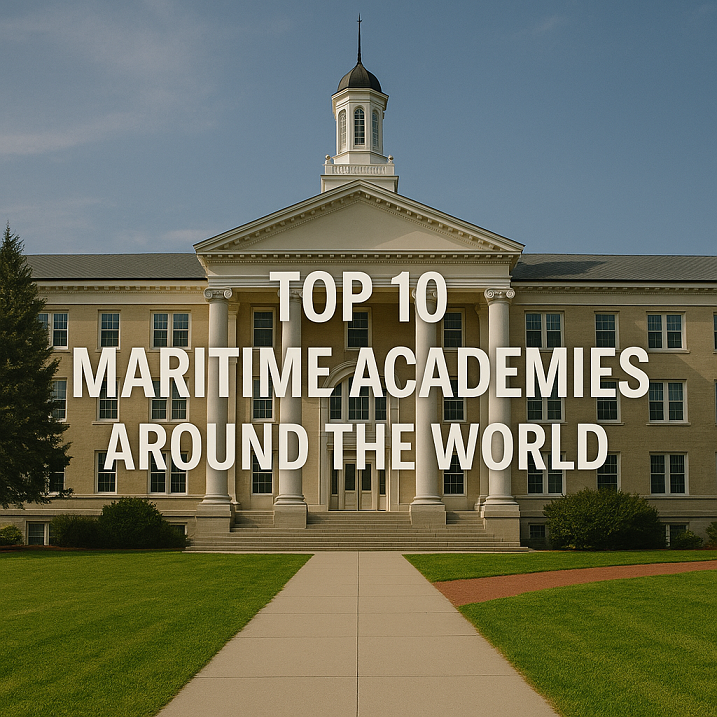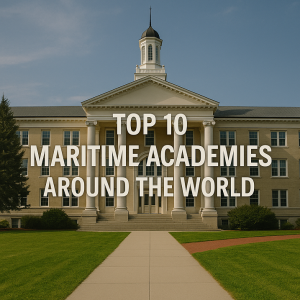Discover the top 10 maritime academies shaping the future of seafaring professionals. Explore academic excellence, global rankings, and how these institutions anchor the maritime industry.
Why Maritime Education Matters in the 21st Century
The global maritime industry transports over 90% of international trade, underpinning the world economy. Behind every vessel, port operation, or maritime innovation are well-trained professionals—captains, engineers, logisticians, and environmental officers—most of whom began their careers in maritime academies.
As the industry pivots toward sustainability, automation, and cybersecurity, the role of maritime education is more critical than ever. Maritime academies are no longer just training grounds for traditional seafaring; they are incubators for the next generation of maritime leaders, technologists, and innovators.
According to the International Maritime Organization (IMO), a shortage of skilled officers—estimated at over 89,000 by 2026—makes high-quality maritime training more than an educational priority; it’s a global imperative.
Criteria for Ranking Maritime Academies
While numerous institutions provide maritime training, the following ten stand out based on:
-
International accreditation (e.g., STCW, IMO White List)
-
Research output and innovation
-
Graduate employability
-
Partnerships with global shipping companies
-
Facilities (simulators, training ships, etc.)
The Top 10 Maritime Academies Shaping Global Shipping
1. World Maritime University (WMU) – Malmö, Sweden
Founded by the International Maritime Organization (IMO) in 1983, WMU is a postgraduate institution designed for mid-career maritime professionals. It focuses on maritime governance, ocean sustainability, and policy development.
Why It Stands Out: WMU is often described as the “Harvard of Maritime Studies,” influencing global maritime policy and education standards.
2. United States Merchant Marine Academy (USMMA) – Kings Point, NY, USA
One of the five U.S. federal service academies, USMMA offers rigorous training in marine engineering, navigation, and logistics.
Unique Feature: The “Sea Year” program sends cadets to commercial vessels, providing hands-on training unmatched in the U.S.
Graduate Impact: Alumni serve in the Merchant Marine, U.S. Navy, and international fleets, many moving into executive roles in global shipping firms.
3. Makarov State University of Maritime and Inland Shipping – Saint Petersburg, Russia
This academy, dating back to 1781, has trained thousands of officers for both maritime and inland fleets.
Facilities: Home to over 40 simulators, including full-mission bridge simulators and engine room trainers, it remains a global powerhouse in practical maritime education.
4. Tokyo University of Marine Science and Technology – Japan
A research-driven university specializing in marine technology, ocean policy, and environmental protection.
Research Strength: Plays a leading role in Japan’s push toward autonomous vessels and maritime AI systems.
Partnership Highlight: Collaborates with ClassNK and MOL for green shipping R&D.
5. Shanghai Maritime University (SMU) – China
A hub for East Asia’s growing maritime dominance, SMU produces engineers, logisticians, and port managers.
Facilities: Includes the largest maritime library in Asia and world-class simulation centers.
International Reach: SMU is part of the International Association of Maritime Universities (IAMU), ensuring global curriculum alignment.
6. California State University Maritime Academy (Cal Maritime) – USA
Specializing in marine transportation, global logistics, and marine engineering technology, Cal Maritime offers both academic rigor and practical training via its annual training cruises.
Noteworthy Stat: Consistently reports a >90% job placement rate within 6 months of graduation.
7. Arab Academy for Science, Technology & Maritime Transport (AASTMT) – Egypt
An IMO-recognized regional center of excellence, AASTMT serves the Arab world with campuses in Alexandria, Cairo, and beyond.
Flagship Programs: Offers dual-degree options and runs one of the most advanced simulator complexes in the Middle East.
Strategic Importance: Close proximity to the Suez Canal makes it a critical player in global shipping education.
8. Australian Maritime College (AMC) – University of Tasmania
Australia’s premier maritime training institution, AMC is known for its cutting-edge hydrodynamic testing facilities and research in maritime safety.
Global Collaboration: Partners with DNV, the Australian Navy, and offshore energy firms.
Unique Offering: Offers degrees in naval architecture and maritime engineering tailored to offshore and renewable energy sectors.
9. Korea Maritime and Ocean University (KMOU) – South Korea
Strategically located in Busan, the world’s sixth-largest port, KMOU is a leader in maritime technology, port logistics, and oceanography.
Innovation Highlight: Works with Hyundai Heavy Industries on smart ship development.
Facilities: KMOU boasts an extensive training ship program and marine robotics lab.
10. Maine Maritime Academy (MMA) – Castine, Maine, USA
A public college offering degree programs in marine engineering, transportation, logistics, and ocean studies.
Fleet Experience: Training Ship State of Maine provides cadets with global sea time and leadership development.
Alumni Success: Graduates are found in commanding roles across the U.S. Merchant Marine and global shipping companies.
The Role of Maritime Academies in Advancing the Industry
Embracing Technology and Sustainability
From autonomous navigation systems to zero-emission propulsion, academies are incorporating real-time simulations and green tech into their curricula. Institutions like WMU and KMOU are leading research on IMO 2050 targets and low-carbon fuel transitions.
Bridging the Skills Gap
With over 50,000 new officers needed annually to meet global demand (BIMCO/ICS Report, 2021), maritime academies serve as a primary talent pipeline. Partnerships with companies like Maersk, NYK Line, and Shell ensure students graduate with industry-relevant skills.
Real-World Applications and Success Stories
-
WMU Alumni in the IMO: Many senior IMO officials and delegates began their careers at WMU, influencing international maritime law and climate strategy.
-
MMA to the Arctic: In 2022, cadets from Maine Maritime Academy joined a scientific expedition aboard a NOAA vessel, collecting real-time climate data in the Arctic Circle.
-
SMU in Shanghai Port Operations: Over 60% of Shanghai Port’s technical and planning staff are SMU graduates.
Frequently Asked Questions (FAQ)
Q1: What’s the difference between a maritime academy and a naval academy?
A: Maritime academies focus on commercial shipping and civilian careers, while naval academies prepare students for military service.
Q2: Do I need a degree to work on ships?
A: Not always. Many roles only require STCW certifications, though degrees provide better career mobility and shore-based options.
Q3: Are maritime degrees internationally recognized?
A: Yes, especially if the academy complies with STCW and is listed on the IMO White List.
Q4: What’s the cost of maritime education?
A: It varies by country. U.S. academies may charge $25,000–$40,000/year, while some state-funded schools or scholarships (e.g., WMU, AASTMT) offer subsidized options.
Q5: How do I choose the right academy?
A: Consider factors like location, accreditation, job placement rates, sea-time availability, and specialization areas (e.g., logistics, engineering, policy).
Q6: Can women apply to these academies?
A: Absolutely. All the academies listed promote diversity, with rising female enrollment in engineering and command tracks.
Q7: What are job prospects after graduation?
A: Strong. Graduates work in marine engineering, logistics, ports, classification societies, and maritime administration roles.
Conclusion
The top maritime academies around the world are more than just schools—they’re the beating heart of global shipping. These institutions equip students with the technical expertise, leadership skills, and global mindset needed for today’s rapidly evolving maritime sector.
Whether you’re drawn to the high seas, the innovation labs, or port control towers, the right maritime academy can chart a course to a rewarding and impactful career.
Ready to start your maritime journey? Explore academy profiles, admission tips, and career pathways at MaritimEducation.com.
References
-
BIMCO/ICS. (2021). Seafarer Workforce Report. https://www.ics-shipping.org
-
International Maritime Organization. (2023). Global Maritime Training Insights. https://www.imo.org
-
World Maritime University. (2024). Annual Review. https://www.wmu.se
-
Cruise Lines International Association. (2024). Global Market Report. https://cruising.org
-
Australian Maritime College. (2024). Facilities & Research. https://www.amc.edu.au


